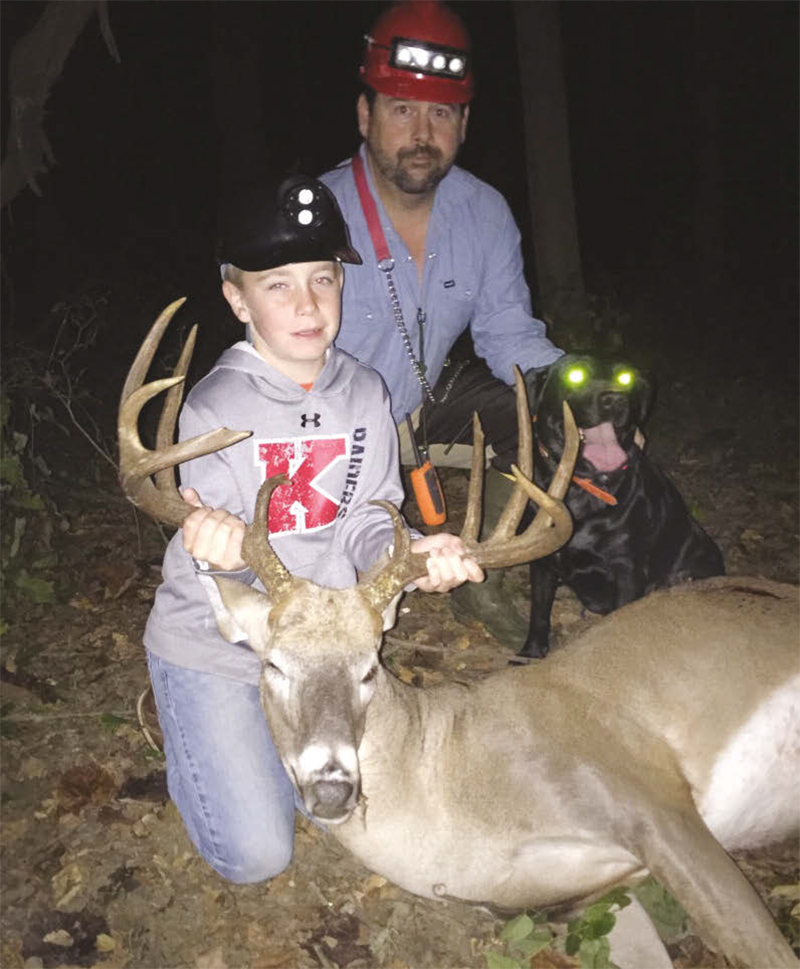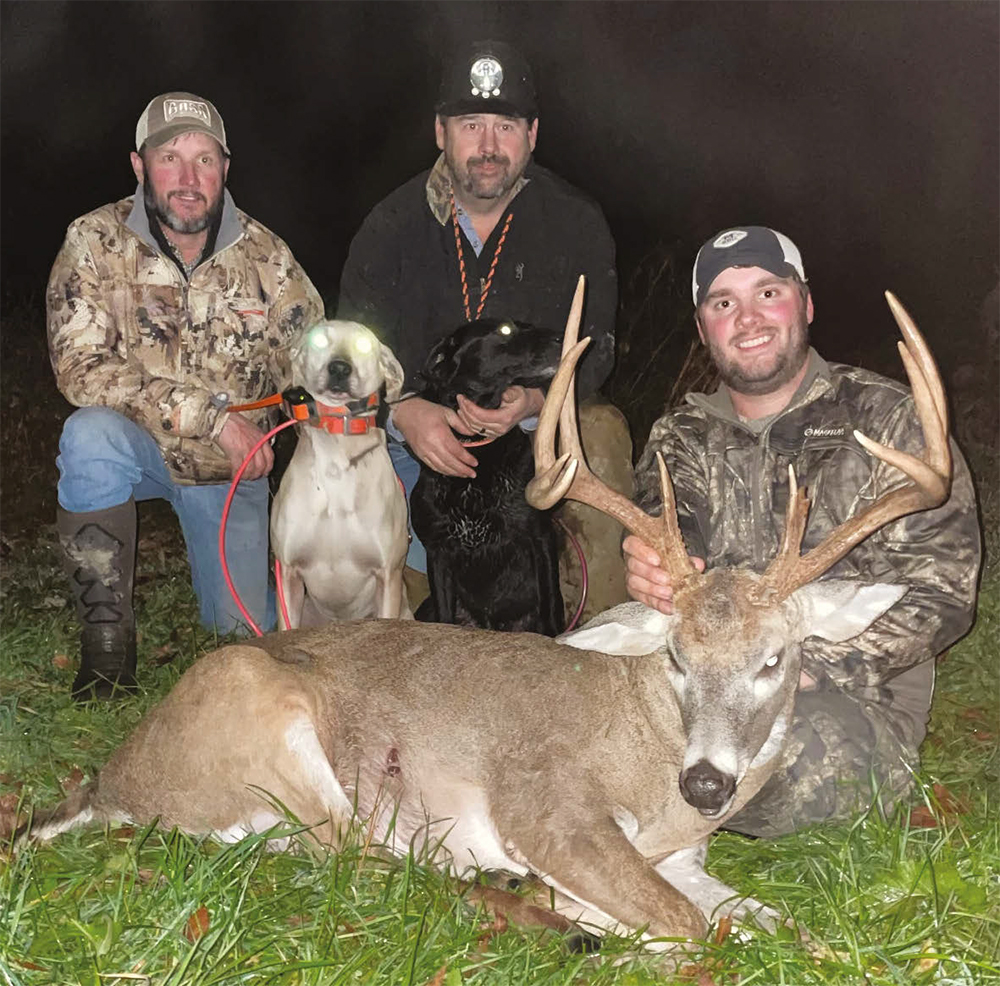By KATIE TIMS • Photos provided by CHAD SMITH
When it comes to finding deer, Chad Smith’s dogs are on the job.

Last season, a guy named Si bagged better than one hundred deer in the Delta. It was a good go but nothing out of the ordinary for this dedicated hunter. He’s been at it for seven seasons straight now, and his yearly count is typically three digits deep. His trusty companion Whitney has a record almost as impressive.
Neither Si (pronounced “sigh”) nor Whitney own a gun. They don’t shoot a bow, dress in camo, wait in a deer stand, or have a license. And yet their reputations precede them—two of the South’s best and most talented deer tracking dogs.
It started with cow dogs
Chad Smith, a farmer in Leland owns Si and Whitney. He’s the go-to person when a hunter shoots (or mis-shoots) a buck that gets up, runs off, and cannot be found.
“You have to make every effort—morally and ethically—to recover your deer,” Chad says. “It’s the humane thing to do. If you don’t, the coyotes are going to kill the deer, or it is going to suffer for days and then die. No hunter wants that on his or her conscience.”
Chad is passionate about tracking, a hobby he took up years ago.
“I grew up on a cattle ranch in the hills near Greenwood,” Chad says. “There was a lot of wooded area, cut-over, and not much ag ground. It’s not like you could ride out there and see a cow five hundred yards across the field. That’s why you had to have a dog that would go hunt—that would track that cow until it found it.”
Chad believes the black mouth cur is the ideal cow dog.
“Their natural instinct is to bay,” he says, explaining that “baying” is when a dog barks and contains the tracked animal. “We could handle our dogs—call them back, keeping them behind your horse until you sent them forward again to help push the cattle. But our black mouth curs could also go track a cow and bay, which is something a heeler or border collie won’t usually do.”
According to the United Kennel Club, the black mouth cur was developed in Mississippi and Tennessee during the nineteenth century, crossed and selected for its work ethic, guardianship, and tracking abilities. Today, the UKC recognizes the black mouth cur as an official purebred herding dog (the American Kennel Club has yet to include the breed on its roster). Black mouth curs range in color, weigh fifty to one hundred pounds, stand at about eighteen inches, and are usually characterized by the black hair around their muzzles and eyes.
“They’re so versatile,” Chad adds. “You train them to hunt what you want them to hunt.”
And, just so you know, Disney’s famous Old Yeller was a black mouth cur.

Generational tracking
As a kid Chad spent a lot of time with his grandfather, Robert Acy, who had one special gyp (term for a female dog) that tracked both cows and deer.
“Jill knew the difference between the two,” Chad says. “During hunting season, a neighbor would call asking for help. We’d set her loose at night, and she knew we were looking for a deer. If it was in the day time, she would stay focused on the cows and not run the deer. She was a very intelligent dog.”
Thanks to mentoring from his grandfather, Chad learned to train his own tracking dogs.
“We would go find three, four, or five deer every season—just me, my brother, and the neighbors,” Chad recalls. “We didn’t have tracking collars—just little bitty cowbells on their collars. You’d hear it going through the woods, and when it stopped you just walked in that direction.”
By high school, Chad and his brother were tracking about twenty deer a season. In college, the numbers grew even higher. The hobby indulged Chad’s love for dogs, passion for hunting, and the gratification that missing deer were recovered. Chad married his wife, Gay, and they had two children. The couple lived for a time in Grenada and then moved a few years ago to Leland, where Chad manages a farm. They have a son, Cauy, fifteen, and daughter Kylie, ten.
Farming allows Chad the freedom to track deer during hunting season. He has bred, bought, and trained several dogs, and these days Chad successfully recovers around one hundred deer per season.
“I track for all the camps up and down the Mississippi River,” Chad says, adding that sometimes there is more work than time. “I’ve had to learn how to say no. It’s hard because I want to go find every one of those deer.”
Thankfully, there’s a second generation taking up the craft. Cauy is following in his dad’s footsteps.
“If it’s not a school night, he’s in the truck with me tracking,” Chad says happily. “Once he gets his driver’s license, he’ll be able to go out on some of his own tracking calls.”

Trust the dog
Using dogs for tracking deer is not legal in every state, and here in the Delta it’s acceptable only for recovery purposes. In other words, hunters don’t use dogs to find deer to hunt—they bring in dogs to track deer that have already been shot by a bullet or arrow.
Chad is an expert tracker, and he’s often tapped for seminars at hunting expos where he offers instruction for hunters who lose sight of their shot deer.
“Walk over to where the deer was standing, look for signs—blood, hair, or whatever sign you can find,” he advises. “If you can track that deer one hundred or 150 yards and you don’t find him, it’s a pretty good chance that you didn’t make a good shot.”
Often, Chad says, the hunter finds blood and bone fragments where the deer was hit.
“They usually think it’s rib bone,” he adds. “I have found over a thousand deer, and I’ve never seen rib bone—it’s the leg every time, 100 percent of the time. And a leg-shot deer will not be dead—100 percent of the time.”
That presents a problem.
“That deer is out there two hundred yards, suffering,” Chad explains. “Then have humans out there walking through the woods with the flashlights, talking—it makes that deer get up and run two hundred more yards. You’ll never walk up on him.”
That’s why, Chad advises, it’s best to call in tracking dogs. By the time a hunter gives up searching and calls in a tracker to find the missing deer, many hours have passed, the weather might have changed, and the scent trail is confused.
“When you go to looking for your deer, you’re not thinking about what you’re doing,” Chad says. “You’re just walking down the trail with a flashlight thinking that you’re fixin’ to find your deer. When that doesn’t happen and the blood stops, then you go to searching—walking around in circles.”
When Chad arrives, he asks the hunter several questions and then sets his dogs loose. Immediately, the hunter’s path shows up on the handheld GPS device that connects with the dogs’ collars.
“The line will go pretty much straight along a predictable path, and then it goes crazy,” Chad says. “That tells me where the hunter stopped tracking and started searching in circles and back and forth. It takes a few minutes—sometimes as much as a half hour—for the dog to get all of that worked out. Then you’ll see the line start back off.”
Another challenge is when a hunter swears the deer was shot “right there,” but the tracking dog heads in the other direction.
“It happens every year,” Chad says. “That hunter is looking at you like, ‘Man, your dog doesn’t know what he’s doing!’ I tell them, ‘If it’s not right, that dog will be back.’ More times than not he goes and finds the deer.”
Chad harkens back to advice his grandfather offered years ago about dogs and tracking.
“He told me, ‘That dog can smell better than you can see. You trust him until you can prove him wrong.’ It’s wisdom that I’ve lived by.”

Team effort
Chad’s dogs are dedicated and tenacious but never aggressive toward the deer.
“Typically, if dogs run in and try to catch the deer, it’s going to cause it to break and run. My dogs can sense how badly hurt the deer is. They will do a wider circle on a deer that is not hurt real bad, and they’ll bay closer in on the ones that are badly hurt. Those are things you just can’t teach.”
Tracking dogs don’t rely solely on blood to track an injured deer.
“A deer that is mortally wounded produces a specific pheromone, and that’s how the dog differentiates,” Chad explains. “There could have been ten other deer there when the guy shot that buck. But when you turn that dog loose, it’s able to track the right deer through all the other tracks.”
Granted, the black mouth cur is Chad’s first go-to dog for tracking. But it’s a Labrador retriever that is Chad’s all-time favorite. Si is an eight-year-old Lab, and the dog has successfully tracked 647 deer. Chad’s number two dog is Whitney, a four-year-old black mouth cur.
“They work totally differently, but they complement each other really well,” Chad says about the two dogs. “The cur can’t handle the cold water like the Lab can. The Lab has a colder nose [can track an older track]. Si has run some tracks that were forty hours old. Cur dog is a little grittier and tougher, which is also important.”
Si started as a drug dog. The North Mississippi Drug Task Force bought him as a puppy and sent him to school, which he flunked.
“Obviously it wasn’t his nose!” Chad says with a chuckle, adding that Si has an amazing sense of smell. “He was six months old when I got him and had been through all the obedience training. He had a such a drive to please—everything he did he wanted to please me.”
Si tracked his first deer at ten months old.
“I don’t think I’ll ever be without a Lab just because of the territory I’m in and all the water,” Chad says. “I’ve watched my Lab swim the Mississippi River behind a deer, several times. Plus, he’ll bay. If you hear him in the woods at night, you’d think he was a cur dog. He’s pretty intense.”
As for Whitney, she belonged to one of Chad’s best friends. When that friend, Jim, was killed in a crop duster crash, the family asked Chad to take Whitney. She was still a puppy and had a tough time bonding to her new owner. Chad knew he needed to keep the dog, and so he asked his mentor, Keith Watson, for advice.
“He told me to leave the old dog home and send Whitney in to track by herself,” Chad says.
That chance arrived shortly thereafter. Chad got the call about a “monster” deer that was shot over by Greenwood. Initially, Chad doubted the “monster” claim, but then he saw the trail cam. The guy was not exaggerating—this was a special buck that needed to be located ASAP.
The problem was Chad had brought Whitney and left Si home.
“In the back of my mind I’m thinking, ‘Alright, in thirty minutes I’m fixin’ to go home and get my old dog and come back,’” Chad recalls. “The hunter told me he saw the deer laying on the ditch bank, but when I turned the dog loose, she kept going the other way. It was an absolute s*** show for the first fifteen minutes.”
Then, on top of everything else, Chad finds out the deer is somewhere out in the field where his friend Jim was killed.
“Finally, I sat down under the tree where my friend was killed, and I told the people to get in the buggy and leave.”
With the distractions gone, Chad set Whitney loose and she headed out the way she wanted to go. A few minutes later Chad’s phone rang. The dog located the injured deer—on the opposite side of the field.
“That was the first deer that she ever found by herself, and it was in the field where Jim crashed,” Chad says. “It still gives me chill bumps every time I think about it.”

This season
As soon as bow season opens, Chad and his dogs will be front and center on the tracking trail. Along with Si and Whitney, Chad has a ten-month-old and a two-year-old – both black mouth curs—who’ll get the chance to track their first deer.
As for that dream dog…“I’m really thinking about crossing Si and Whitney,” Chad admits. “In a perfect world you’d like to have the best of the cur dog qualities and the best of the Lab dog qualities, all bundled up in one dog. But that just doesn’t happen.”
Deer trackers have their definite preferences in dogs. Several different breeds are used—one couple in Alabama swears by a pair of wire-haired dachshunds!
“I have the question asked a hundred times a winter, ‘What is the best dog for tracking?’” Chad says. “I tell them, ‘It’s personal preference. But remember, that dog is going to be a tracking tool for three months out of the year; he’s going to be a pet for nine.”
Chad emphasizes the importance of socializing his working dogs.
“You’ve got to have a dog that will stay focused on the job at hand and still be friendly. It’s got to be both ways. Because when we do find that deer, I want little Johnny to be able to hold this dog next to that buck and get his picture taken.”




